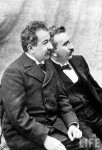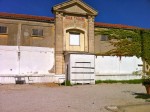 The world’s oldest surviving public movie theater, the Eden Theatre in the town of La Ciotat 20 miles east of Marseille on the south coast of France, has been restored and reopened after 30 years of neglect. In a gala opening on Wednesday, October 9th, this little town’s prominent place in film history was reclaimed with a showing of some of the first moving pictures ever filmed, shot in 1895 by the Lumière brothers in La Ciotat’s summer sun.
The world’s oldest surviving public movie theater, the Eden Theatre in the town of La Ciotat 20 miles east of Marseille on the south coast of France, has been restored and reopened after 30 years of neglect. In a gala opening on Wednesday, October 9th, this little town’s prominent place in film history was reclaimed with a showing of some of the first moving pictures ever filmed, shot in 1895 by the Lumière brothers in La Ciotat’s summer sun.
 In 1892, Antoine Lumière, father of the soon-to-be-famous brothers, had a seaside mansion built in La Ciotat. A friend of his had introduced him to the town and he had fallen in love with its charms. After construction on the Tuscan-style villa known as Château Lumière was completed in 1893, entire family spent summers there. The timing was ideal to make the sleepy town of 12,000 a dominant figure in movie history. According to one popular view of events, Antoine saw Edison’s Kinetoscope in Paris in 1894 and suggested to his sons that they look into improving on Edison’s device which was heavy, dependent on electricity and only allowed one person at a time to view the motion picture through a peephole.
In 1892, Antoine Lumière, father of the soon-to-be-famous brothers, had a seaside mansion built in La Ciotat. A friend of his had introduced him to the town and he had fallen in love with its charms. After construction on the Tuscan-style villa known as Château Lumière was completed in 1893, entire family spent summers there. The timing was ideal to make the sleepy town of 12,000 a dominant figure in movie history. According to one popular view of events, Antoine saw Edison’s Kinetoscope in Paris in 1894 and suggested to his sons that they look into improving on Edison’s device which was heavy, dependent on electricity and only allowed one person at a time to view the motion picture through a peephole.
 Within months, Louis had invented combination device that shot the film, developed it and projected it. The brothers patented the Cinématographe on February 13th, 1895, using the name of an earlier recording and projecting device patented by Léon Bouly in February of 1892. By 1894 Bouly could no longer afford the fees to renew his patents, so the Lumière’s snapped up the name. Some historians believe Louis took more than just the name from Bouly’s device, but if so, he improved upon it drastically. Louis insisted he came up with the idea all on his own, denying even the story about his father and the Kinetoscope.
Within months, Louis had invented combination device that shot the film, developed it and projected it. The brothers patented the Cinématographe on February 13th, 1895, using the name of an earlier recording and projecting device patented by Léon Bouly in February of 1892. By 1894 Bouly could no longer afford the fees to renew his patents, so the Lumière’s snapped up the name. Some historians believe Louis took more than just the name from Bouly’s device, but if so, he improved upon it drastically. Louis insisted he came up with the idea all on his own, denying even the story about his father and the Kinetoscope.
On March 22nd, 1895, the first movie audience witnessed La Sortie de l’Usine (“Exiting the factory”), less than a minute of footage of workers, mainly women, leaving the Lumière photographic plate factory in Lyons shot three days before the showing. This demonstration took place in Paris for a private audience at the Société d’Encouragement pour l’Industrie Nationale (Society for the Encouragement of National Industry). The theme was advances in photography, and indeed very early color photographic film debuted at the same event. Louis was surprised that his moving picture got far more attention than the advent of color.
[youtube=http://youtu.be/6TwV4uCrDhY&w=430]
After this successful debut, the Lumières held private, invitation-only showings of their film shorts in various cities in France and Belgium. La Ciotat was among them, with a screening held on September 21st in the grand salon of the Château Lumière. Several of the shorts were filmed in La Ciotat. La Mer recorded kids jumping off a rickety one-plank pier into the ocean. Le Repas de Bébé starred Auguste and his wife Marguerite feeding their baby girl Andrée in the garden of the Château. That sweet bébé would die tragically at the young age of 24 in the influenza pandemic of 1918.
[youtube=http://youtu.be/eSdrbpMMGeo&w=430]
[youtube=http://youtu.be/CAbTn3KzkgY&w=430]
Those shorts were among the 10 on the bill for the first film screening for a paying public audience on December 28th, 1895, at the Salon Indien du Grand Café in Paris. The most famous Lumière film of all which was shot at La Ciotat was not shown at the Salon Indien but debuted shortly thereafter in January of 1896. Arrivé d’un Train à La Ciotat captures the arrival of a train into the station. There’s an urban legend that when audiences first saw that train barreling towards the camera, they panicked and fled to the back of the theater out of fear of the approaching iron horse. That didn’t actually happen. This wasn’t the first movie ever shown and people were quite capable of distinguishing between a real train and a filmed one.
[youtube=http://youtu.be/v6i3uccnZhQ&w=430]
All the articles I’ve read about the restored theater claim Arrivé d’un Train à La Ciotat was the first movie shown at the Eden. This appears to be a new urban legend hitching a ride on the pre-existing urban legend of the screaming audiences terrified of the moving train. In fact, the first moving picture shown at the Eden Theater in La Ciotat was Barque Sortant du Port, in which three men in the Lumière party attempt to row a boat past a jetty into some choppy waters only to be turned back by the waves. It debuted on March 21st, 1899, before an audience of 250. The poster advertising the show has survived, so we know the boat came first, followed by a train trip over the Alps, American cowboys lassoing horses (Western themes were popular even before there were actual scripted movies), baby’s first meal projected in color, a camel caravan at the Pyramids of Giza and more.
[youtube=https://youtu.be/zdVn4wwYd6M&w=430]
It was this 1899 screening that secures for the Eden the title of the world’s oldest movie theater. The Salon Indien du Grand Café was gone by the time of the 1900 Paris Exposition Universelle. None of the other early theaters have survived either. Built in 1889, the Eden was a coffee house/music hall that put on vaudeville shows, concerts and plays as well as boxing and Greco-Roman wrestling events. Live programming continued even after it added film to its repertoire. Yves Montand performed there when he was a scrappy youth. So did Edith Piaf.
In 1981, a group of local film enthusiasts founded le Festival du Berceau du Cinéma (the Festival of the Cradle of Cinema). For two days in July, the Eden Theater showed the Lumière Brothers’ films that started it all using the authentic original Cinématographe, first of the series, that had projected the movies at the Salon Indien in 1895. The festival was a smashing success, so much so that the town must be very grateful they weren’t using the original highly flammable nitrate film stock because there were 700 spectators crammed into a 380-seat theater.
 That was a small tactical victory, however, in a losing war. The Eden’s illustrious history was marred almost to the breaking point in 1982 when its manager, Georges Giordana, 25, was murdered during an attempted robbery. The city was already in a steep economic decline, devastated by the demise of the shipbuilding industry. The Eden, hobbled and decaying, stopped showing regular movies. It only opened one week a year for the festival, which continued to draw huge crowds, until 1995 when it was permanently shuttered and left to crumble.
That was a small tactical victory, however, in a losing war. The Eden’s illustrious history was marred almost to the breaking point in 1982 when its manager, Georges Giordana, 25, was murdered during an attempted robbery. The city was already in a steep economic decline, devastated by the demise of the shipbuilding industry. The Eden, hobbled and decaying, stopped showing regular movies. It only opened one week a year for the festival, which continued to draw huge crowds, until 1995 when it was permanently shuttered and left to crumble.
 The festival inspired conservationists to campaign to save the Eden, but political infighting and a lack of funds blocked all attempts at restoration. Finally in 2008, a breakthrough: Marseille was declared European Capital of Culture for 2013. Jean-Claude Gaudin, mayor of Marseille, takes on the restoration of the Eden as a flagship project for the 2013 celebration. It took two more years to prise the necessary €6 million ($8 million) out of the government.
The festival inspired conservationists to campaign to save the Eden, but political infighting and a lack of funds blocked all attempts at restoration. Finally in 2008, a breakthrough: Marseille was declared European Capital of Culture for 2013. Jean-Claude Gaudin, mayor of Marseille, takes on the restoration of the Eden as a flagship project for the 2013 celebration. It took two more years to prise the necessary €6 million ($8 million) out of the government.
 Now the work is finally done. There oak floors where the ratty old carpet used to be, new red velvet seats (166 of them, in keeping with reasonable fire codes for such a small space) and a beautiful yellow and grey-painted facade with mosaic decorations. There’s a permanent exhibition showcasing the history of moving pictures and La Ciotat’s pivotal role therein. At night, the facade is lit by a laser installation of a train in honor of the famous 1895 short.
Now the work is finally done. There oak floors where the ratty old carpet used to be, new red velvet seats (166 of them, in keeping with reasonable fire codes for such a small space) and a beautiful yellow and grey-painted facade with mosaic decorations. There’s a permanent exhibition showcasing the history of moving pictures and La Ciotat’s pivotal role therein. At night, the facade is lit by a laser installation of a train in honor of the famous 1895 short.
1896…117 years ago…wonder when the last of those people meeting the train died…the little girl who appears briefly…she might have been six…amazing films, and more amazing every year.
Your blog is a real treasure….
Going to the cinema was once such an elegant evening out.